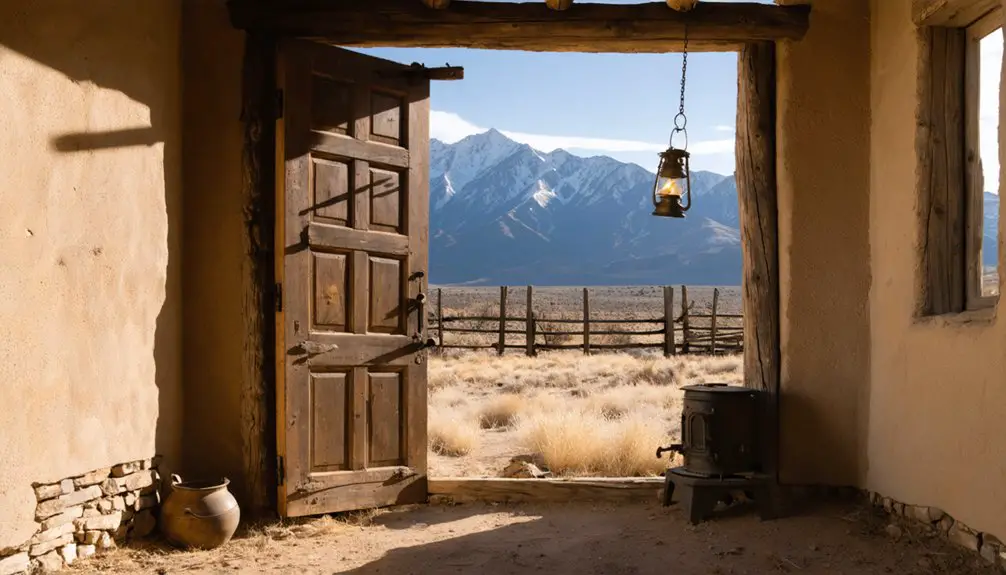Venture into Taos County’s ghost towns to discover New Mexico’s rich mining heritage from the late 1800s. You’ll find weathered remnants of once-bustling communities like Elizabethtown, which housed up to 9,000 residents during its 1869 peak, and Midnight, with its legendary Silver Dollar Saloon. These abandoned settlements, shaped by seasonal mining from May through September, yielded over $6 million in precious metals by 1907. The rugged mountain terrain holds countless untold stories of fortune seekers and frontier life.
Key Takeaways
- Elizabethtown, once home to 9,000 residents during the 1869 gold rush, stands as Taos County’s largest and most historically significant ghost town.
- Midnight’s weathered log cabins, Silver Dollar Saloon ruins, and historic post office offer glimpses into late 1800s mining life.
- La Belle and Twining feature authentic mining-era structures and artifacts, though they’re less visited than other Taos County ghost towns.
- Ghost town visits are best planned during dry months (May-September) when unpaved mountain roads are most accessible.
- Many sites require off-road vehicles or hiking to access, and visitors should bring GPS coordinates, water, and emergency supplies.
The Mining Legacy That Shaped Taos County
While Spanish prospectors first tapped into Taos County’s mineral wealth in the late 1600s, the area’s mining legacy truly took shape in the mid-1800s with the development of the Copper King mine near Red River in 1867.
Spanish explorers unlocked Taos County’s riches centuries ago, but the Copper King mine marked the true birth of its mining era.
This discovery sparked a transformation that would forever change the region’s landscape and economy.
You’ll find that new mining techniques in the early 1900s breathed fresh life into the area, as companies like American Consolidated Mines and Fraser Mountain Company extracted gold and copper deposits.
Low-grade ore and high processing costs eventually contributed to the decline of many mining operations in the region.
The Ernie Blake development in the mid-1950s eventually shifted the region’s focus from mining to skiing, marking a new era of economic growth.
The economic impacts rippled through the region as mining camps evolved into settlements, complete with railroads and roads connecting once-isolated areas.
Though weather conditions and fluctuating mineral demands created boom-bust cycles, the industry’s influence remains evident in the ghost towns and historic sites that dot Taos County’s terrain today.
Lost Towns of the Moreno Valley Gold Rush
After discovering gold in Willow Creek in 1866, the Moreno Valley transformed into New Mexico’s most lucrative gold district, producing $6 million in precious metals by 1907.
Mining operations were limited to seasonal work from May through September due to heavy winter snows.
The gold rush impact swept through the region as 3,000 fortune seekers flooded into bustling Elizabethtown by 1868.
You’ll find evidence of ambitious mining technology in the remains of the 40-mile Moreno Water and Mining Company ditch, where 420 workers once labored to supply critical water to mining operations.
By 1899, the area surrounding Mt. Baldy had yielded $3 million worth of gold.
The massive aqueduct bridged arroyos and crossed valleys on 79-foot trestles, though water scarcity ultimately proved insurmountable.
While individual miners initially staked their claims freely, the boom wouldn’t last.
Exploring the Ruins of Midnight
Deep in Taos County’s rugged backcountry, the ghost town of Midnight stands as a tribute to New Mexico’s fleeting gold fever of the late 19th century. The town supported small mining businesses including a general store and local blacksmith shop. The region joined the US territory in 1850, bringing new waves of prospectors to these mountains.
Midnight lore tells of a settlement shrouded in perpetual shade from towering trees, where nearly 200 souls once sought their fortunes between 1895 and 1898.
You’ll discover these haunting remnants of the past:
- Weathered log cabin ruins scattered across the mountainous terrain
- Ghostly artifacts like historic cans and porcelain fragments
- The legendary site of the Silver Dollar Saloon, where silver coins once adorned the bar
- Mysterious foundations hidden among native vegetation
- Remnants of the original post office that marked the town’s brief existence
Today, these remote ruins beckon only the most adventurous explorers willing to venture off the beaten path.
What Remains: A Guide to Ghost Town Classification
Understanding how ghost towns are classified helps visitors and researchers better appreciate these historic sites.
Proper classification of ghost towns provides essential context for exploring and studying these windows into our past.
You’ll find that experts use different frameworks to categorize these abandoned places based on their current state and historical significance. Ghost Town USA’s system ranges from barren sites with minimal remains to busy historic communities, while Western Mining History focuses on the distinction between fully abandoned and near-ghost towns. According to expert T. Lindsay Baker, a key requirement is that the reason for existence of a town must have disappeared.
For accurate assessment within Wikipedia, ghost towns are rated on a quality scale from Featured Article down to Stub class to indicate their level of documentation and completeness.
When you explore these sites, you’ll encounter various stages of preservation: barren locations with only foundations remaining, crumbling ruins with roofless structures, classic ghost towns featuring intact buildings, and semi-ghost towns still hosting small populations.
These ghost town classifications help you identify what to expect and how to approach each site, whether you’re seeking visible ruins or tracking down the invisible footprints of history.
Native American Heritage and Mining Conflicts
Long before ghost towns dotted the Taos County landscape, the region’s Native American inhabitants established deep cultural and spiritual connections to the land. The area’s rich mining history, particularly around the Cerrillos Hills, reveals a complex story of Indigenous resilience and conflict with European settlers. The arrival of Spanish colonizers in the early 1500s sparked violent clashes that would shape the region for centuries to come. The Pueblo Revolt in 1680 marked a significant uprising against Spanish rule, resulting in hundreds of colonizer casualties and the destruction of religious buildings.
- Taos Pueblo, constructed by the Northern Tiwa tribe, stands as a symbol of cultural preservation, dating back to 1000-1450 A.D.
- Traditional turquoise mines like Mount Chalchihuitl showcase Native American mining expertise predating European arrival.
- Indigenous communities maintained religious and ceremonial practices despite colonization pressures.
- Mining booms in the 19th and 20th centuries disrupted traditional Native lands.
- The Pueblo’s UNESCO World Heritage status recognizes its enduring cultural significance.
The intersecting histories of Native peoples and mining operations continue to shape Taos County’s identity today.
Life in Taos County’s Boom Towns
In Taos County’s mining boom towns, you’d find a rigidly structured society where mine owners and managers occupied the highest social positions, while laborers, merchants, and service workers formed distinct social tiers below them.
Your daily routine as a miner would’ve involved grueling 12-hour shifts extracting ore and timber, with constant risks from cave-ins, toxic gases, and primitive extraction methods.
After work, you’d join other miners at boarding houses and saloons that served as community hubs, where miners shared meals, exchanged news, and found brief respite from the harsh realities of mining life.
Daily Mining Life Activities
Life in Taos County’s mining boom towns revolved around the grueling demands of mineral extraction, with daily routines shaped by the harsh realities of mountain living and resource limitations.
You’d find miners wielding mining tools like picks and pans from dawn to dusk, battling the elements in their quest for precious metals.
- Early shifts began with basic equipment in hand-dug tunnels and creek-side operations
- Work seasons fluctuated with weather conditions, especially during harsh winter months
- Mining camps started as temporary tent cities before evolving into proper settlements
- Daily routines centered around communal meals and organized work rotations
- Stamp mills and ore processing defined the rhythm of daily operations
The demanding schedule didn’t end with daylight – you’d spend evenings maintaining equipment, planning next day’s excavations, or unwinding in local saloons after exhausting shifts.
Mining Town Social Structure
While mineral discoveries drew thousands to Taos County’s mining settlements, distinct social hierarchies quickly emerged that would shape daily interactions and opportunities.
At the top, you’d find mine owners and company officials wielding economic power over everything from housing to store prices. Below them, skilled workers like engineers and surveyors enjoyed better living conditions, while laborers performed the backbreaking work of extracting ore.
Women, though fewer in number, carved out essential roles running boarding houses and laundries. The diverse population included Anglo-American miners, Hispanic settlers, and Taos Puebloans, creating a complex social fabric.
In these company-controlled towns, social classes determined where you lived, worked, and socialized – from the refined company offices to the crowded workers’ quarters.
The Rise and Fall of Elizabethtown
You’ll find Elizabethtown’s most prosperous era during 1869, when the population swelled to between 5,000 and 9,000 residents, making it New Mexico Territory’s largest settlement.
The town’s infrastructure expanded to meet the needs of its bustling population, boasting over 100 buildings including hotels, stores, saloons, churches, and a school.
Peak Population Years
The explosive growth of Elizabethtown began in 1866 when gold discoveries sparked a mining rush that transformed this remote New Mexico settlement into the territory’s most populous town.
By 1869, you’d have witnessed remarkable population dynamics as the town swelled to 7,000 residents, driven by social upheaval and the promise of mineral wealth.
During these peak years, you’d have found:
- A bustling commercial district with 100 buildings
- Seven saloons featuring large dance floors and gambling
- Three dance halls catering to miners and travelers
- A thriving red-light district near the town center
- Essential services including a brewery, flour depot, and drugstore
Nearly 3,000 miners worked the claims while Texas cattlemen established ranches, creating a diverse economy that temporarily sustained this booming frontier settlement.
Mining Prosperity Ends
Despite initial prosperity from rich gold deposits, Elizabethtown’s mining fortunes began declining sharply in the 1870s as high-grade ore yields diminished.
You’ll find that economic downturns hit the region hard, forcing many miners to abandon their claims and seek opportunities elsewhere. The Colfax County War, involving heated mining conflicts over land rights, further destabilized the area until an 1888 Supreme Court ruling attempted to settle disputes.
While you would’ve witnessed a brief revival in the 1890s with the arrival of the railroad and modern dredging technology, this resurgence proved short-lived.
Hidden Gems: Lesser-Known Ghost Town Sites
Beyond well-trodden tourist paths, Taos County harbors fascinating ghost towns like Midnight, La Belle, and Twining, each telling a unique story of New Mexico’s mining era.
These hidden history sites offer intriguing opportunities for urban exploration, though you’ll need to venture off maintained roads to discover them.
- Most sites feature dilapidated structures and foundations, revealing clues about past mining communities.
- You’ll find these locations less documented than famous ghost towns like Madrid.
- Access typically requires off-road travel or hiking through rugged terrain.
- Limited signage means you’ll need local knowledge or detailed maps.
- Many sites intersect with Native American lands, adding cultural significance.
These lesser-known locations reward adventurous spirits with authentic glimpses into Taos County’s rich mining heritage, though deteriorating conditions demand careful exploration.
Preservation Challenges in Mountain Terrain
You’ll find preservation work in Taos County’s ghost towns frequently halted by harsh winter storms and spring mudslides that block mountain access roads for weeks at a time.
The region’s dramatic freeze-thaw cycles have caused extensive damage to original stone foundations, with many structures from the 1800s now showing dangerous levels of instability.
The surrounding wilderness steadily encroaches on these historic sites, as aspens and pines take root in abandoned buildings while native grasses push through weathered floorboards.
Weather’s Impact On Access
While exploring Taos County’s ghost towns offers a fascinating glimpse into New Mexico’s mining history, the region’s severe weather patterns greatly impact access to these remote sites.
You’ll need to carefully plan your visits around seasonal challenges and be prepared for rapidly changing conditions that can affect your journey.
Key weather-related access considerations include:
- Winter snow and ice create hazardous driving conditions on mountain roads
- Flash floods from heavy rains can wash out access routes and trails
- Spring freeze-thaw cycles cause extensive road deterioration
- Early snowfall can unexpectedly close mountain passes
- Remote locations limit emergency response during severe weather
For the safest experience, equip yourself with a high-clearance or four-wheel-drive vehicle, monitor weather forecasts closely, and maintain flexible travel plans when visiting these historic sites.
Crumbling Foundations Challenge
Despite decades of exposure to harsh mountain conditions, the deteriorating foundations of Taos County’s ghost towns present one of the most pressing preservation challenges in New Mexico’s historic mining district.
You’ll notice the stark evidence of foundation failures throughout these remote sites, where mountain terrain and freeze-thaw cycles have accelerated structural deterioration.
Foundation assessments reveal how historic construction methods, lacking modern reinforcement, have left these sites particularly vulnerable.
Root intrusion from mountain vegetation and wildlife activity continue to destabilize the original stonework, while seasonal runoff erodes the surrounding soil.
Modern restoration techniques are complicated by difficult access and limited resources.
You’ll find preservation efforts further constrained by the need to balance authentic historical integrity with safety concerns, especially given the complexities of working in remote federal lands.
Wilderness Reclaims History
Nature’s relentless advance into Taos County’s ghost towns exemplifies the power of wilderness to reclaim human settlements.
You’ll witness vegetation challenges as mountainous terrain accelerates natural reclamation, while wildlife impact intensifies structural deterioration.
These remote outposts face nature’s persistent assault through:
- Fast-growing native trees and shrubs concealing historic structures
- Animals burrowing into foundations and nesting in abandoned buildings
- Seasonal freeze-thaw cycles breaking down stone and mortar
- Heavy snow loads threatening to collapse aging roofs
- Harsh winds and rain eroding century-old walls
You’re confronting a dynamic where wilderness preservation laws often restrict intervention, leaving these historic sites vulnerable to nature’s advance.
The remote locations and difficult terrain limit preservation efforts, while local wildlife continues claiming these abandoned spaces as their own habitat.
Planning Your Ghost Town Adventure
Before commencing on a ghost town expedition in Taos County, you’ll need to carefully assess both your destination and timing.
Focus on easily accessible sites like Anchor, with its preserved log cabin ruins nestled above 10,000 feet in dense pine forest. You’ll find ideal conditions during dry months when unpaved roads are passable.
Pack essential supplies, including water, emergency gear, and proper ghost town etiquette guidelines.
Bring a high-quality camera with wide-angle lens for photography tips: capture both sweeping landscapes and minute architectural details.
Research GPS coordinates in advance, as Anchor and Midnight sites are often confused.
Consider altitude sickness risks and weather patterns that can change rapidly at these elevations.
Remember to document your findings while adhering to Leave No Trace principles.
Frequently Asked Questions
Are Any Taos County Ghost Towns Considered Haunted by Local Residents?
You’ll find haunted legends surrounding Midnight, Duchesne, and Twining ghost towns, where local folklore tells of spectral miners, unexplained lights, and eerie sounds near abandoned mines and buildings.
What Survival Gear Should I Pack for Ghost Town Exploration?
Pack your survival essentials: multiple compasses, waterproof maps, LED lights, sturdy boots, protective gear, multi-tool, survival knife, first aid supplies, dust masks, and emergency medical equipment for safe exploration.
Can I Legally Collect Artifacts Found in Taos Ghost Towns?
You can’t legally collect artifacts from ghost towns without permits, as federal and state regulations protect these sites. Focus on photos and preservation instead of removing historical pieces.
Which Ghost Towns Are Accessible During Winter Months in Taos County?
You’ll find winter accessibility varies, but Elizabethtown’s your best bet with proper 4×4 transport. Check ghost town maps and local conditions before venturing out – many sites become snowbound and inaccessible.
Are There Guided Tours Specifically Focused on Taos County Ghost Towns?
You won’t find guided ghost tours specifically focused on Taos County ghost towns. Instead, local tour operators concentrate on downtown Taos’s paranormal activity while sharing local history through guided walking tours.
References
- https://sites.rootsweb.com/~nma/GhostTowns/ghost_townsnm.html
- https://www.newmexico.org/places-to-visit/ghost-towns/
- https://en.wikipedia.org/wiki/List_of_ghost_towns_in_New_Mexico
- https://newmexiconomad.com/elizabethtown/
- https://www.ghosttowns.com/states/nm/nmtaos.html
- https://www.vtsv.org/how-do-i/learn-about/village-history/
- https://redrivernmhistoricalsociety.org/1867-1905-mining-days/
- https://agmc.info/wp-content/uploads/simple-file-list/New-Mexico-documents/New_Mexico_Mining_History.pdf
- https://sites.lsa.umich.edu/earth315/wp-content/uploads/sites/1380/2024/11/Jahns76_NWGS_HardingMine.pdf
- https://www.dws.state.nm.us/Portals/0/DM/LMI/Mining_Winter_2013.pdf



